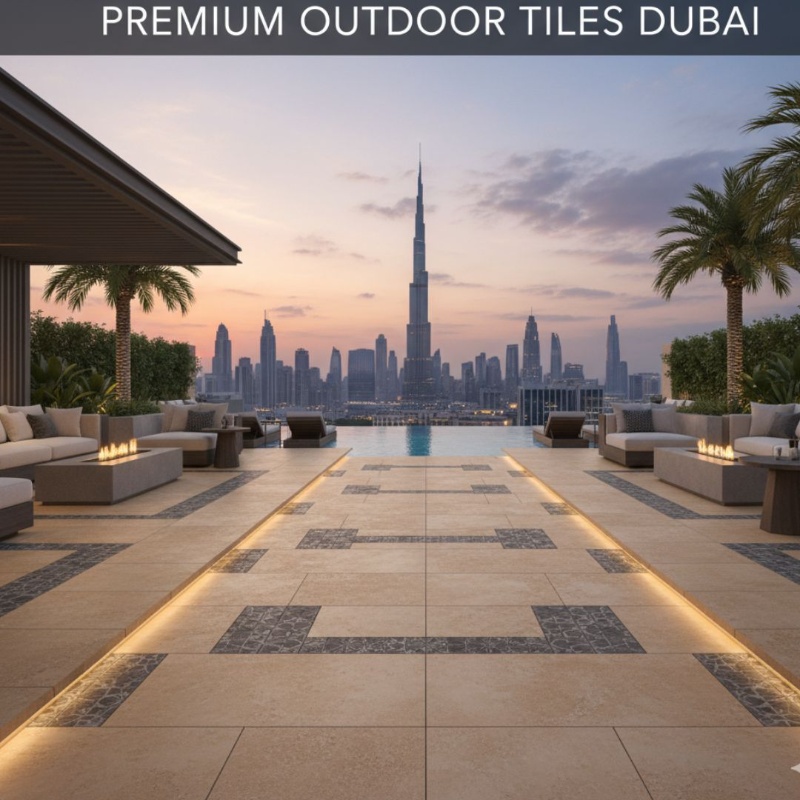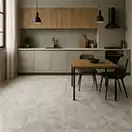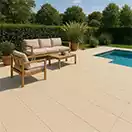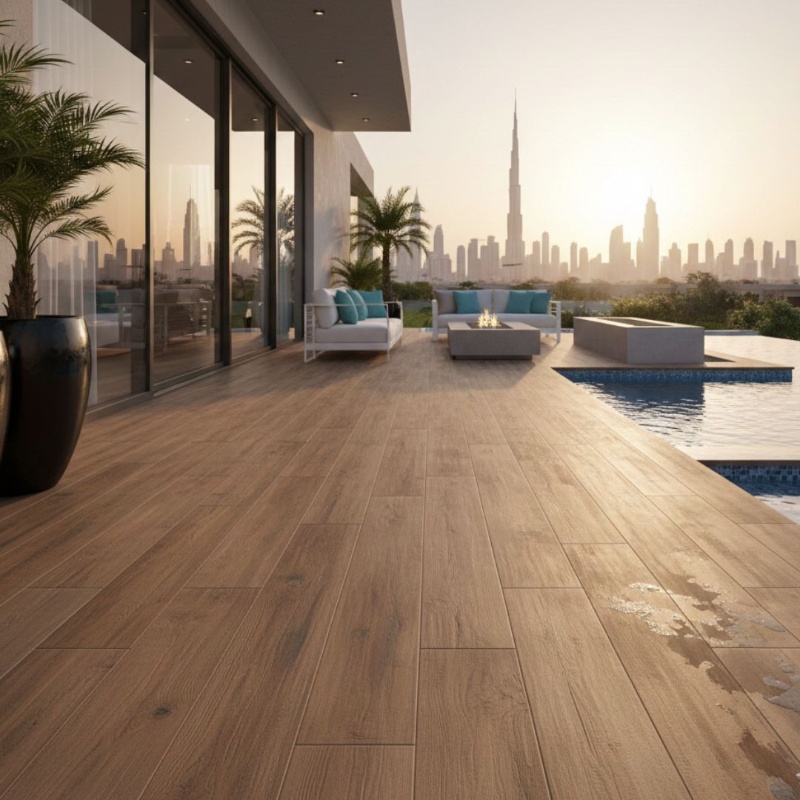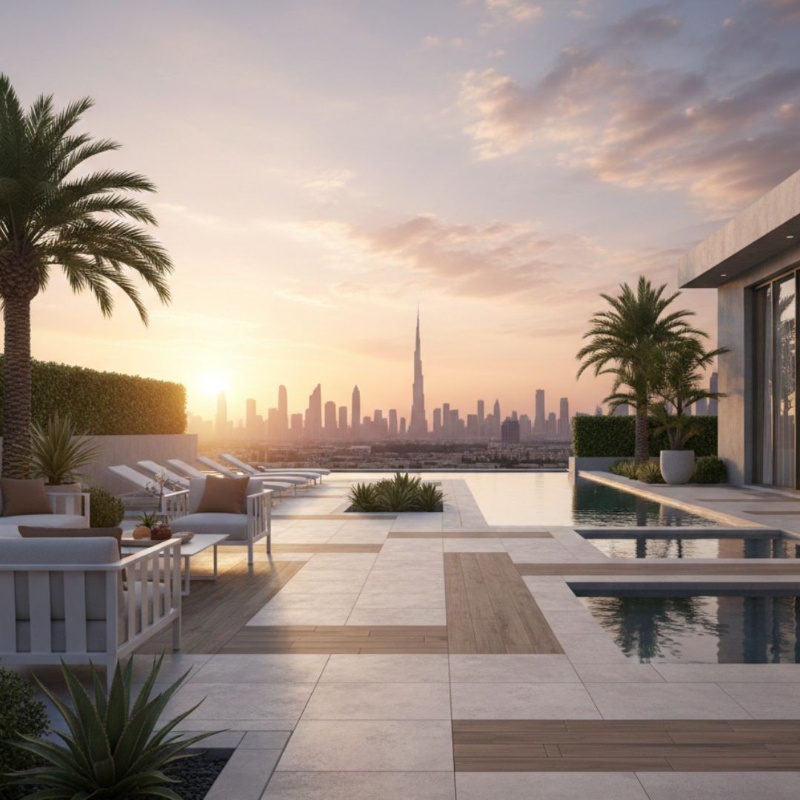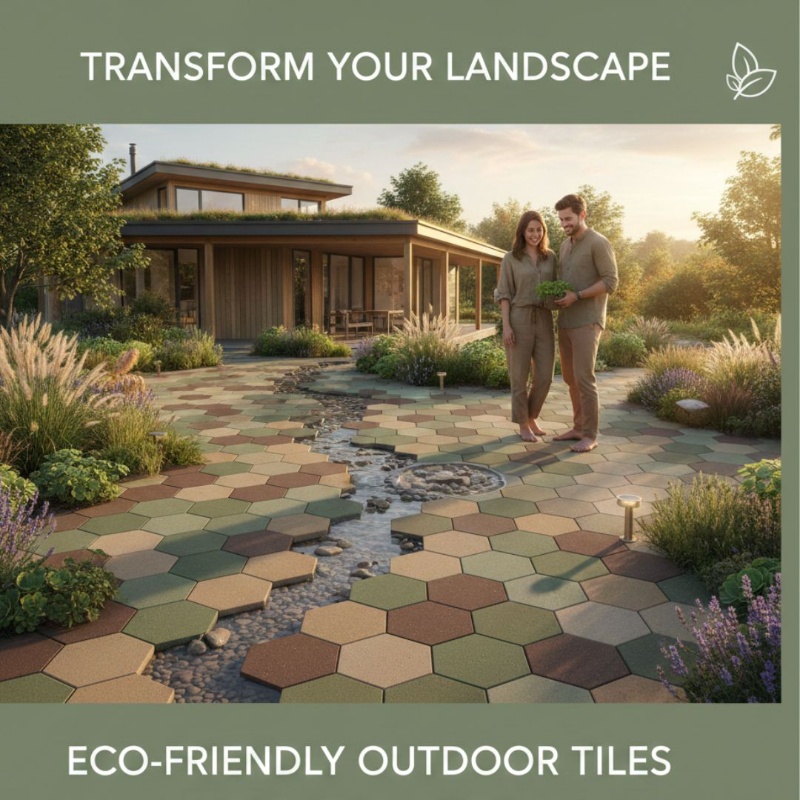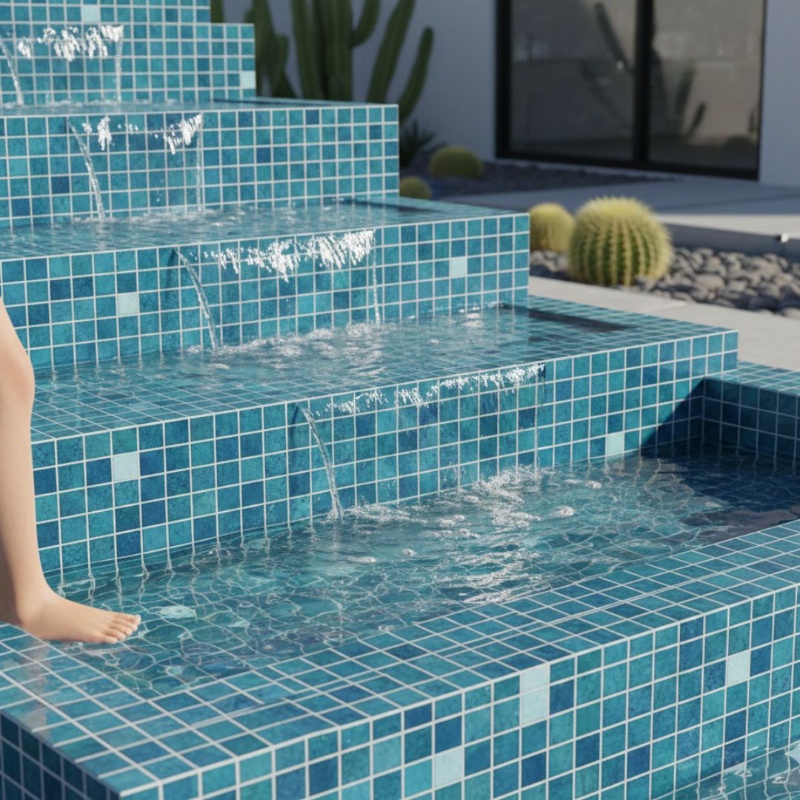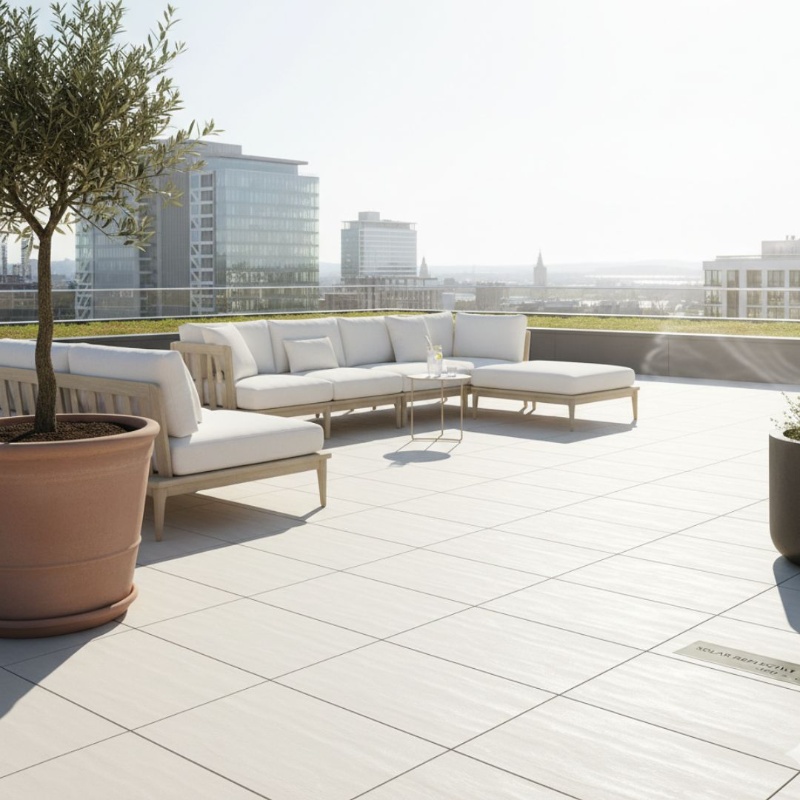Premium Outdoor Tiles Design in Dubai
Key Points
- Outdoor tiles design must balance beauty, safety, durability, & climate. all these things are
- In Dubai, premium outdoor tiles need to withstand heat, sun, occasional moisture, and thermal conditions as the weather is harsh, so the quality of outdoor tile matters
- Weatherproof tiles for homes are designed to resist fading, slipping, cracking, and moisture infiltration.
- Prioritize materials like porcelain, natural stone treated for exterior use, or certain ceramics rated for outdoors.
- Use proper base, drainage, and joint design when installing.
- Regular cleaning and sealing can prolong tile life.
Cost depends on material, size, labor, shipping, and finishing.
Why Outdoor Tiles Design Matters
Outdoor spaces, including balconies, patios, terraces, and gardens, are extensions of your home. A good home/villa outdoor tile design:
- Enhances curb appeal
- Ensures safety with slip resistance
- Survives all type of weather & wear
- Adds functional value
Bad design can lead to slipping, cracking, fading, or premature replacement.
Types of Outdoor Tiles
|
Tile Type |
Pros |
Cons |
Best Use |
| Porcelain tiles | Very dense (complicated), low |
More expensive |
Patio floors, walkways |
| Natural stone (granite, slate, limestone, sandstone) | Beautiful texture |
May need extra maintenance, can absorb water | Decks, garden paths |
|
Quarry tiles / Terracotta |
Rough, look, natural tones | Less frost resistance, may need sealing | Low-traffic outdoor zones |
|
Ceramic tiles |
Many style options |
Must check outdoor rating |
Covered patios, shaded areas |
|
Composite/Engineered outdoor tiles |
Lightweight, wood-look options |
Newer materials—check durability |
Rooftop terraces, balcony decks |
When picking, ensure the tile is rated for outdoor use (look for specs like water absorption ≤ 0.5%, PEI rating, frost resistance, slip rating).
What Makes Tiles “Premium” in Dubai
“Premium outdoor tiles in Dubai,” which means tiles that pass the basic standards. Characteristics include:
- Very low water absorption (resists moisture)
- High strength ( good strong made )
- UV rays stability (resists fading under the sun)
- Excellent slip-resistance
- Precision in size & edges, a sharp look
- Good quality warranty & brand reputation
- Imported quality or high-end local manufacturing
Premium doesn’t just mean expensive—it means quality, longevity, and performance in harsh climates.
Weather and Climate Challenges in Dubai
Dubai’s climate brings unique stresses:
- High heat and UV rays: you need high-quality porcelain or ceramic tiles, color fading
- Dry conditions with occasional rain: thermal expansion & contraction
- Sand and wind: abrasion and dust infiltration (need a good quality tile to handle this)
- Humidity near coastal zones: moisture intrusion (in the summers, it becomes more humid from June to August; we need to have this point in mind).
A tile may look fine indoors but fail outdoors without proper design for these stresses.
Features to Look for: Weatherproof Tiles for Homes
When choosing weatherproof tiles for homes,
- Slip Resistance
Look for ratings like R11 or R12 (European) or suitable US standards. Especially around pools or wet zones.
- Frost & Thermal Resistance
Even though Dubai doesn’t freeze, the cycles of heat & cooling matter.
- UV Stability / Color Fastness
Tiles must keep color under long sun exposure.
- Abrasion / Wear Rating
Especially for high foot traffic areas.
- Edge Quality
Straight, easy fixation with a perfect edge
- Thickness & Support
Adequate thickness (usually 20 mm or more in exposed areas) and proper sub-base support.
Choosing Styles, Colors, and Textures
- Light colors reflect heat; dark ones absorb it. Choose mid- to light tones outdoors.
- Textured surfaces (stone, leather, and grooved) help reduce slip.
- Coordinated design: match or contrast with indoor flooring, walls, garden, furniture.
- Pattern options: large-format tiles reduce grout lines; mosaics or smaller tiles allow curves and detailing.
Borders, inlays, or accent strips add visual interest.
Installation Tips for Outdoor Tiles
- Proper Base/Substrate: A stable mortar bed or concrete slab with steel reinforcement if needed.
- Slope/Drainage: A slight slope (e.g. 1–2%) away from the house to avoid water pooling.
- Joint/Grout Design: Use flexible grout/sealant; allow expansion joints.
- Right Adhesive: Use adhesives rated for exterior use and high temperature.
- Thermal Joint Lines: Especially for large areas, include expansion joints to allow movement.
- Edge Protection/Profiles: Use edging trims or profiles to protect tile edges.
Maintenance & Care
- Sweep regularly to remove grit/sand.
- Use pH-neutral cleaners; avoid harsh acids or salts.
- Reseal porous or natural stone tiles every 1–2 years (if required).
- Inspect for cracks or loose tiles and repair early.
- Remove stains or organic growth (moss) gently
Cost Factors & Budgeting
| Cost Element | Influence | Range / Notes |
| Tile material & brand | Premium vs standard | Premium tiles cost 2–4× more |
|
Size & thickness |
Thicker, larger tiles cost more |
20 mm outdoor tiles cost more than 10 mm |
|
Import & shipping |
Especially for imported premium tiles |
Shipping from Europe, Asia increases cost |
|
Labor / installation complexity |
Slope, substrate, logistics |
Skilled labor costs more |
|
Finishing & sealing |
Surface treatments |
Extra cost for sealing, edging |
| Waste & breakage margin | Extra stock needed |
Usually 5–10% extra tiles |
Sample Designs & Ideas
- Pool surrounded by anti?slip porcelain in light gray tones
- Terrace with wood-look porcelain slats laid in alternating directions
- Garden path with natural slate strips and gravel in between
- Roof terrace mosaic inset borders framing large field tiles
- Patio with contrast border bands around the edge
Visual consistency, texture, and functional zones (dining, seating, and plants) help the design flow.
FAQs
What is the ideal thickness for outdoor tiles?
For exposed outdoor areas, 20 mm thickness is common. In covered zones, 10–12 mm may suffice if the substrate is strong.
Can indoor tiles be used outdoors?
Not safely. Indoor tiles often lack weatherproofing (water absorption, UV stability, slip resistance), so they may crack, fade, or become slippery.
How often should outdoor tiles be sealed?
Depends on the material. Natural stone often needs sealing every 1–2 years. Porcelain often doesn’t need sealing, but joints/grout might.
Do I need expansion joints?
Yes. Large tiled areas must include expansion / movement joints to accommodate thermal expansion and prevent cracking.
How to choose grout color?
Match or slightly contrast with tile color. Use light colors to reflect heat, but ensure durability and stain resistance.
Are premium outdoor tiles worth the extra cost?
Yes, especially in Dubai’s climate. They last longer, resist fading and damage, and reduce long-term replacement costs.
Conclusion & Key Takeaways
- Outdoor tiles design must combine aesthetics, safety, and durability.
- In Dubai, premium outdoor tiles in Dubai must be capable of resisting heat, UV, and moisture cycles.
- Always check for weatherproof tiles for homes, focusing on water absorption, slip resistance, UV stability, and structural strength.
- Careful planning—from design, substrate, and slope to installation—is essential.
- Maintenance and occasional sealing keep tiles looking fresh for years.
- Though premium tiles cost more initially, they often save money in the long run due to fewer repairs or replacements.
If you like, I can also prepare a gallery of design images for outdoor tiles or a Dubai?based supplier list. Do you want me to do that next?
